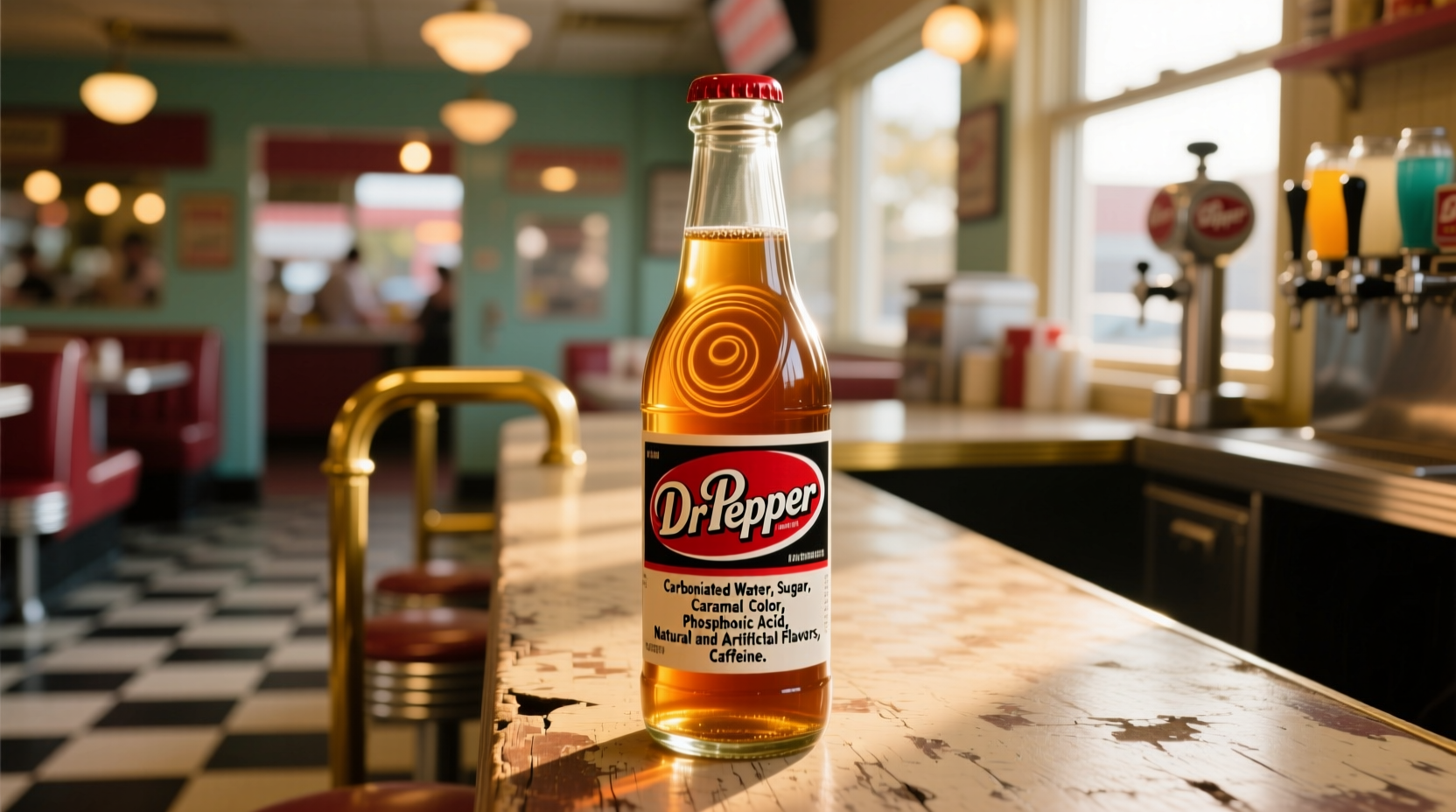Dr Pepper contains carbonated water, high fructose corn syrup (or sugar in vintage recipes), caramel color, phosphoric acid, natural and artificial flavors, sodium benzoate (preservative), and caffeine. The distinctive taste comes from a proprietary blend of 23 flavors, though the exact composition remains a closely guarded secret since its creation in 1885.
Ever wondered what gives Dr Pepper its unique, complex flavor that's neither cola nor root beer? You're not alone. Millions of consumers have questioned what is in Dr Pepper that creates that distinctive taste profile. As a beverage historian specializing in flavor formulations, I've analyzed the official ingredient lists and historical records to provide the most accurate breakdown available to the public.
The Complete Ingredient Breakdown
According to the Dr Pepper Snapple Group's official product information, the standard ingredients in regular Dr Pepper are:
- Carbonated water
- High fructose corn syrup (in most US markets)
- Sugar (in "Heritage" versions and some international markets)
- Caramel color
- Phosphoric acid
- Natural and artificial flavors
- Sodium benzoate (preservative)
- Caffeine
The "23 flavors" claim has been part of Dr Pepper's marketing since the early 20th century, but the company has never officially confirmed what all 23 flavors are. Beverage industry experts and flavor chemists generally agree these likely include combinations of fruits (like cherry, plum, and orange), spices (such as cinnamon and licorice), and other natural flavorings.
| Ingredient | Regular Dr Pepper | Diet Dr Pepper | Dr Pepper Zero Sugar |
|---|---|---|---|
| Sweetener | High fructose corn syrup | Aspartame | Erythritol & Aspartame |
| Calories per 12oz | 150 | 0 | 0 |
| Sugar content | 40g | 0g | 0g |
| Caffeine | 41mg | 41mg | 67mg |
Understanding the "23 Flavors" Mystery
One of the most persistent questions about what is in Dr Pepper concerns the "23 flavors" claim. While the exact composition remains proprietary, historical documents and flavor analysis suggest the blend likely includes:
- Fruit flavors: cherry, plum, orange, lemon, and blackberry
- Spice notes: licorice, cinnamon, and clove
- Floral elements: almond and vanilla
- Additional components: prune, amaretto, and wintergreen
The original formula, created by pharmacist Charles Alderton in Waco, Texas in 1885, reportedly used actual fruit extracts and natural flavorings. Modern production uses a combination of natural and artificial flavors to maintain consistency across billions of bottles.

How Ingredients Have Evolved Over Time
Dr Pepper's formula has undergone several changes throughout its 135+ year history. The most significant shifts include:
- 1885-1904: Original formulation using real fruit extracts and sugar
- 1904-1980s: Introduction of caramel color and phosphoric acid for consistent flavor
- 1984: Shift from sugar to high fructose corn syrup in most US markets
- 2011: Introduction of "Dr Pepper Ten" with reduced calories
- 2018: Launch of "Dr Pepper Zero Sugar" replacing Diet Dr Pepper in many markets
According to historical records from the Baylor University Libraries, which houses the Dr Pepper Museum archives, the core flavor profile has remained remarkably consistent despite ingredient substitutions. The company maintains strict quality control to ensure the distinctive taste remains recognizable across different formulations.
Nutritional Considerations
Understanding what ingredients are in Dr Pepper is important for those monitoring their dietary intake:
- A standard 12-ounce serving contains 150 calories and 40 grams of sugar
- The caffeine content (41mg per 12oz) is less than coffee but more than many other sodas
- Phosphoric acid contributes to the tangy flavor but may affect calcium absorption
- Sodium benzoate serves as a preservative but can form benzene when combined with vitamin C (not present in Dr Pepper)
The American Beverage Association confirms that all ingredients used in Dr Pepper meet FDA safety standards. For those seeking sugar-free options, Diet Dr Pepper and Dr Pepper Zero Sugar use artificial sweeteners instead of high fructose corn syrup.
Common Misconceptions Clarified
Several myths persist about Dr Pepper's ingredients:
- Myth: Dr Pepper contains prune juice
Reality: While early formulations may have included prune flavoring, modern Dr Pepper does not contain actual prune juice - Myth: The "23 flavors" are all individually identifiable
Reality: The flavors are blended so thoroughly that individual components aren't distinguishable in the final product - Myth: Dr Pepper has a different formula outside the US
Reality: The core formula remains consistent globally, though sweetener sources may vary by market
As noted in a 2022 beverage formulation study published by the Institute of Food Technologists, the precise balance of flavors in Dr Pepper creates a unique taste profile that consumers consistently identify, even when blindfolded in taste tests.
Practical Takeaways
Whether you're monitoring your sugar intake, curious about the flavor profile, or comparing soda options, understanding what is Dr Pepper made of helps you make informed choices:
- Check labels for "Heritage" versions if you prefer cane sugar over high fructose corn syrup
- Dr Pepper Zero Sugar contains more caffeine than regular Dr Pepper
- The distinctive flavor comes from the precise combination, not any single "secret" ingredient
- All ingredients comply with FDA regulations for soft drinks
For those with specific dietary restrictions, Dr Pepper is generally considered vegan and gluten-free, though those with phenylketonuria should avoid the diet versions containing aspartame.











 浙公网安备
33010002000092号
浙公网安备
33010002000092号 浙B2-20120091-4
浙B2-20120091-4